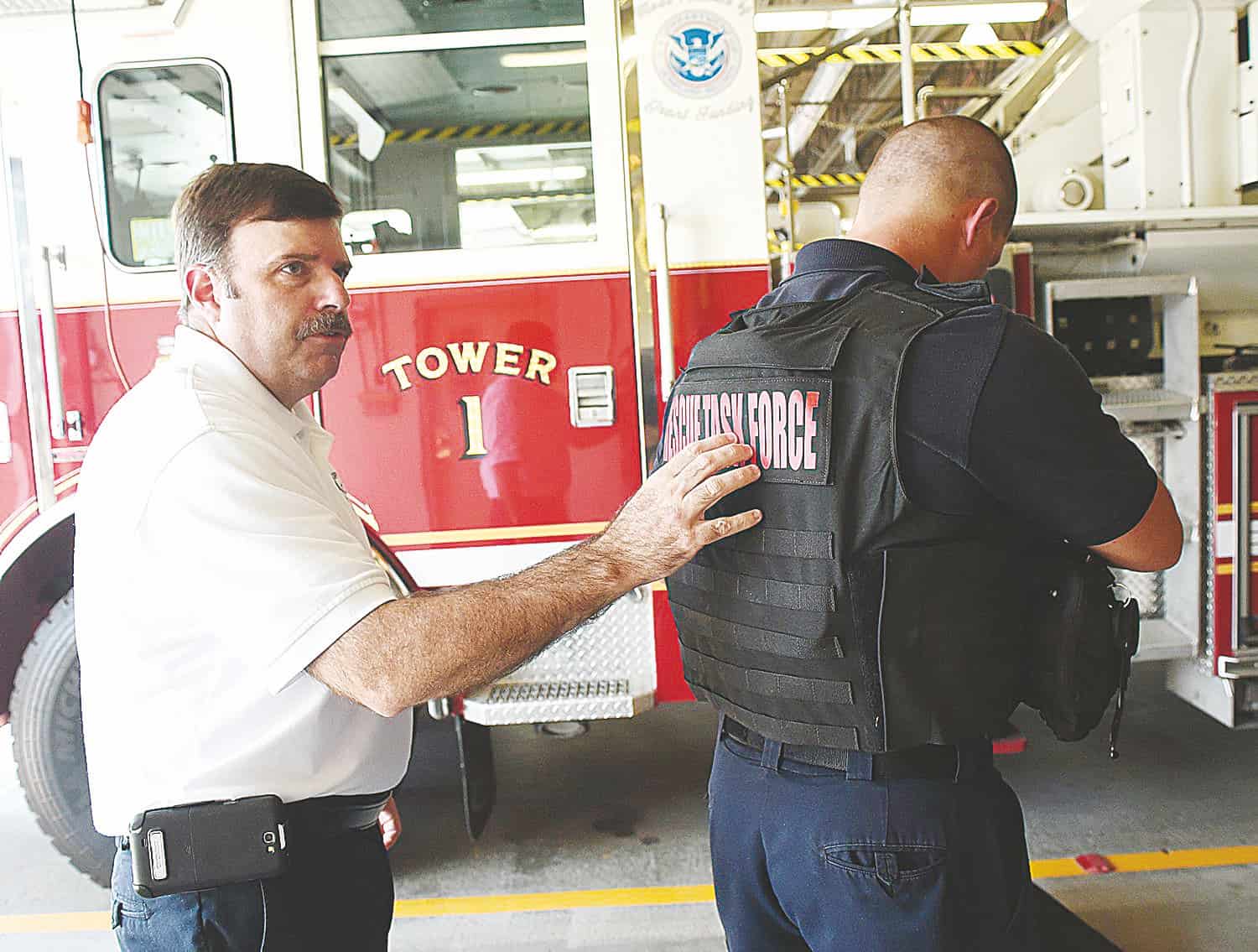Fire Chief Richard O’Brien purchased $11,000 in equipment he hopes his crews never use.
A pair of Kevlar helmets and ballistic vests will ride along with other gear in two separate ambulances, readily available to help medical personnel get inside a shooting scene quicker to treat the wounded. “The sooner the patient gets patient care, the higher the survival rate,” O’Brien said last week at the Church Street fire station.
Asked how often his department might use them in actual situations, the chief said: “Hopefully, never; hopefully, never. “The state this month is conducting its first joint training session with police and emergency medical services crews involving handling an active shooting scene and treating victims quicker. “It goes over law enforcement tactics and the response to a shooter, as well as a new concept that is a best practice of what we call warm zone EMS, which is law enforcement securing the area in a building and allowing EMS to get into a building to treat patients quicker than waiting to search the whole building and deem the whole thing clear,” said Emily Martuscello, an exercise training officer with New Hampshire Homeland Security and Emergency Management.
More fire departments around the state — and throughout the country — are adding the new equipment to their firetrucks, according to Raymond Ballia, president of Body Armor Outlet, which Inc. Magazine just proclaimed as one of the state’s fastest-growing, private companies. The Salem firm sells to fire departments in more than a dozen states, including New Hampshire.
The increased sales to fire departments is a recognition of “being prepared and being ready for situations that are happening more frequently,” he said. “It’s just part of today’s society that agencies beyond police need to be prepared for.
”Most vests, also known as armored vests, ordered by fire departments will stop rounds from handguns and “stop pretty much all rifle rounds and all armor-piercing rounds, so they’re well protected,” Ballia said.
The vests and helmets weigh more than 40 pounds combined.Mass fatal shootings in 2012 at a Colorado movie theater and five months later at Sandy Hook Elementary School in Connecticut spurred more interest in getting to victims quicker to treat them, Martuscello said.“Sandy Hook is the one where the industry as a whole decided things had to change,” said Derry Fire Chief Michael Gagnon.
Derry bought six sets of gear and “we have an active shooter program in town” with joint training with police, he said.“Now we realize we have to provide EMS sooner if we’re going to save lives in these situations sooner,” Gagnon said.
Goffstown’s Chief O’Brien said in the event of a mass shooting, police will clear the immediate area of any shooting threat. A firefighter will be paired with a police officer “to give our rescue people security,” he said.“You’re in that in-between zone where the scene has been secured and there could be a threat, but no on-going threat in that immediate” area, O’Brien said.
Goffstown firefighter Kerry Tower, an advanced EMT, showed off the ballistic vest and helmet last week. He compared his level of concern of entering a shooting scene that wasn’t totally secure to “probably about the same as a fire.“You never know what you’re going into,” Tower said. Goffstown got an $11,000 state grant, funded by the feds, to buy the equipment.In Durham, the fire department bought ballistic vests, which remain in the station for now, according to Fire Chief Corey Landry.
“We’re a higher risk with the university being here and we have the schools,” Landry said.Landry hopes to have joint training with police in the spring.Twenty police and 20 EMS workers will participate in the active shooter training Aug. 26-28 in Nashua.Involving EMS sooner, Martuscello said, is something that grew out of Sandy Hook and other mass shootings.
“It’s taken us a few years to get the protocols in place and requires a lot of joint training together,” she said, noting the new thinking was used by emergency personnel in the recent Louisiana theater shooting.“EMS and police form these teams called rescue task forces of two EMS and four police officers as their security detail and they’ll make entry into a building and get to patients quicker to ultimately provide necessary care for life-theatening injuries,” she said.







